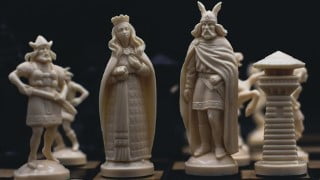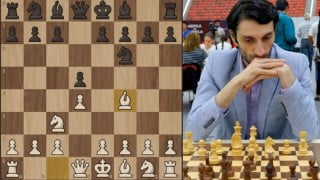Chess Strategy and Tactics: Emanuel Lasker’s Amazing Games
Learn from the games of Emanuel Lasker, the longest-reigning World Chess champion, and discover his influence on modern chess. This course explores Lasker’s strategies, tactics, and openings, as well as his impact on players like Mikhail Tal and Vladimir Kramnik. Improve your understanding of the game and gain insights from Lasker’s brilliant play. Suitable for beginner to intermediate level players.
What you’ll learn
- Ability to appreciate the strength and accuracy of Lasker
- Ability to make use of Lasker’s openings and strategies and tactics
- Ability to see how Lasker’s openings vary according to importance of tournament, simul or World championship event
- Ability to judge of Lasker was a “Poker Chess player” or just had a better understanding of opening theory than his peers
- Ability to improve classical opening knowledge as Lasker played 1…e5 a lot to 1.e4 and 1…d5 to 1.d4
- Ability to understand how to tradeoff structure for central control and development e.g. allowing Nxc5 giving bishop up
- Ability to see more Lasker’s influence on Mikhail Tal and Viktor Korchnoi – especially as a fight – to win
- Ability to apply more Lasker’s concept of the Truth in relation to it’s contrast – e.g. Morphy provided contrast too
- Ability to improve understanding of the King’s Gambit as Lasker played this quite a bit
- Ability to understand more why Mikhail Tal considered Lasker as the greatest of the champions
- Ability to understand more why Vladimir Kramnik considered Lasker a pioneer of modern chess
- Ability to appreciate that Lasker was also a master of the “meta game” making particular opponents feel uncomfortable in particular situations
- Ability to appreciate the Berlin defence old variation as a fantastic solid and potentially advantageous opening foundation for later play with the bishop pair
- Ability to appreciate the Berlin defence as often the bishop without counterpart advantage in exchange for some structural damage which is often not exploitable
- Ability to appreciate statistically anomoly of both Vladimir Kramnik and Emanuel Lasker actually having a positive win % with Black using Berlin defence
- Ability to improve endgames greatly from seeing amazing World championship titanic games getting a variety of endgame tips and strategies
- Ability to train your evaluation of chess positions through the rich experiences of the games and the underlying variations
- Ability to create evocative ideas and concepts and emotions from these games by gaining empathy from the insights and variations to use in one’s own games
- Ability to appreciate Lasker on Chessmetrics best players ever 2 year period #2 behind Kasparov and 20 year period ranked #3 just behind Kasparov and Karpov
- Ability to appreciate the Evolution of chess style has an early link to modern chess in the form of Lasker who often had better tournaments than his successors
- Ability to see influence to World champion Capablanca taking defensive skill and endgame mastery as the specialist subset of Lasker’s style
- Ability to see influence of Alexander Alekhine in terms of attacking chess and the art of Attack
- Ability to see influence to World champion Max Euwe in terms of tactical resourcefulness and solid opening variations
- Ability to see influence of World Mikhail Botvinnik in terms of professional preparation for events – e.g. kept lots of stamina in events and often won in end
- Ability to see influence to World champion Mikhail Tal in terms of being able to create complexity and win from seemingly bad positions
- Ability to see influence to World champion Tigran Petrosian in terms of logic, precision and strong tactical abilities
- Ability to see influence to World champion Bobby Fischer in terms of Universal style and chess as as fight- two cats that are very alike indeed!
- Ability to see infleunce to World champion Anatoly Karpov in terms of universal style and playing the position appropriately and the value of practical moves
- Ability to see influence to World champion Garry Kasparov in terms of exploiting the opponent’s weaknesses in openings, middlegame style and personality general
- Ability to see influence of World champion Vladimir Kramnik in terms of solid aggressive dynamic style and sharing love of Berlin defence 🙂
- Ability to see influence of current World champion Magnus Carlsen in terms of chess as a fight – not a sport, science or Art – but a Fight primarily
- Ability to appreciate Albert Einstein’s comments including Lasker “one of the most interesting people I came to know in my later life”
Show moreShow less
Emanuel Lasker was a German chess player, mathematician, and philosopher who was World Chess champion for an amazing 27 years, from 1894 to 1921. This represents the longest reign of any officially recognized World chess champion in history.
Lasker is regarded by many as one of the strongest chess players in history. Kingscrusher chooses old masters for the greater clarity of understanding their games without the burden so much of modern technical theory. Beautiful ideas are shown in Lasker games and one can also see the influences on future World chess champions such as Mikhail Tal and Vladimir Kramnik who considered Lasker to be one of the strongest players ever. Kramnik considered Lasker to be the link to modern chess.
“I think that Lasker is the discoverer of modern chess. When you look at Steinitz’s games, they have a very 19th-century feel. And Lasker had many games that could be played by any modern player. Lasker is the first link in the chain of “global” chess, where different aspects of struggle are taken into consideration. Steinitz largely emphasized only one positional element. For instance, if he had a better pawn structure and an attack on the King, he thought that his advantage was decisive. And Lasker understood that there are different components of the position that balance each other. He discovered that there are various kinds of advantages, and they are interchangeable: tactical advantage can be transformed into strategical, and vice versa. I think that Lasker was a much stronger chess player than Steinitz. It’s telling that their 1894 World Championship match (let alone the return match) was completely one-sided.”
– Vladimir Kramnik
Indeed it seems many of Lasker’s games even incredibly in simultaneous displays show very high levels of accuracy when checking with the state-of-the-art modern engines such as Stockfish with neural network technology. Between Steinitz and Lasker, the foundations of modern chess were arguably set. The Romantic era of chess was well and truly over, and chess was played in a more principled accurate way. Lasker in particular seemed to be less dogmatic compared to Steinitz, and used “patterns” more in preference to strict principles or ideals, and used these patterns to win games – and generally maximize win probability. Chess for Lasker was primarily a “fight” and not so much a science. Lasker factored in the frailties of being human and appreciate the difficulties of playing certain positions and certain opponents playing certain positions. Taking into account more variables such as the opponent’s strengths and weaknesses made Lasker a more dangerous fighter and warrior of the chessboard.
“A chess game, after all, is a fight in which all possible factors must be made use of, and in which a knowledge of the opponent’s good and bad qualities is of the greatest importance.”
-Emanuel Lasker
There is a claim that Lasker used a psychological approach to the game, and whilst this is true to some extent, the fundamental accuracy of Lasker’s play is undeniable. If Lasker tinted his game towards particular strengths and weaknesses of repeat opponents, then this just seems standard nowadays, and follows the Art of War principles in particular:
“If you know the enemy and know yourself, you need not fear the result of a hundred battles. If you know yourself but not the enemy, for every victory gained you will also suffer a defeat. If you know neither the enemy nor yourself, you will succumb in every battle.”
―Sun Tzu, The Art of War
In this period of time as an example, we see how Lasker defeated Steinitz in two key matches, and Lasker tended to encourage Queenless positions where he felt that Steinitz was not optimal within. This strategy paid off very well, and in fact, Lasker completely crushed Steinitz in the rematch. Lasker went on to prove himself with some major tournament victories establishing his credibility as the World chess champion. This search and eagerness for credibility meant that this was a rich period of playing activity. Lasker himself is quoted as saying:
“… in itself, the title of world champion does not give any significant advantages if it is not acknowledged by the entire chess world, and a champion who does not have the chess world behind him is, in my view, a laughing-stock.”
— Emanuel Lasker
This course time period of Lasker’s chess between 1889-1999 shows the world at the time starting to take Lasker very seriously and accepting his legitimacy as World chess champion. It shows very high accuracy chess and very instructive chess. Kingscrusher has sought the key matches and tournaments which highlight the amazing gifts and advances that Lasker created for the world of chess, and which many of us should pay attention to greatly as Lasker’s play passes the test of time like no other master in his Era. He was truly a link to the modern game. Prepare to be amazed if you study the games in this course!
Who this course is for:
- Beginner to Intermediate level players
User Reviews
Be the first to review “Chess Strategy and Tactics: Emanuel Lasker’s Amazing Games”
You must be logged in to post a review.







There are no reviews yet.